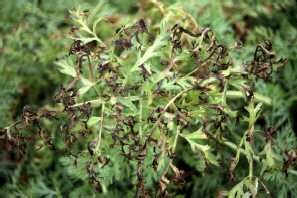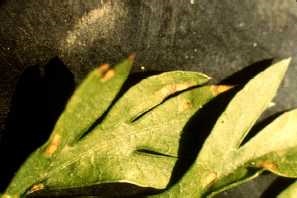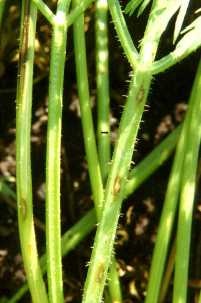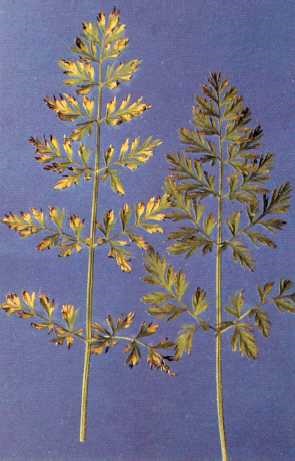Management of carrot leaf diseases
Learn the symptoms, biology, monitoring and management strategies for carrot leaf diseases.
Introduction
Two fungal leaf diseases commonly affect carrots in temperate North America: Alternaria leaf blight and Cercospora leaf spot often weaken the leaves and petioles of carrots making mechanical harvesting less efficient. Bacterial leaf blight may also appear during wet growing seasons or later in the season when rows are closed and is caused by Xanthomonas campestris pv carotae. Harvesting losses tend to be greater if blighted leaves are also affected by heavy frosts. These blights rarely reduce growth of taproots in carrots unless infection occurs early and is left uncontrolled.
Management of carrot leaf diseases depends upon regular and consistent scouting, weather monitoring, disease forecasting, cultural controls and timed fungicide applications at threshold levels. Baby carrots and carrots grown for 'cut and peel' processing may be more susceptible to damage by leaf blights due to planting density and cultivar susceptibility.
Biology and symptoms
Alternaria leaf blight is caused by the fungus Alternaria dauci and is initially characterized by irregularly shaped, brown spots surrounded by a yellow halo along the margins of leaves. (Figure 1)
Alternaria rarely infects the petioles of carrots. If the conditions are good for disease development, the lesions will join together causing the leaflets to shrivel and die appearing as though they are burnt.

Alternaria blight can be easily confused with herbicide injury to carrot leaves also. Alternaria survives on seed and may overwinter on diseased crop residues left in the field as well as on wild carrot plants.
The fungal spore can be spread by wind, insects, water splashes, farm machinery and field workers. Cool, humid weather generally favours Alternaria blight. (Figure 2)

Cercospora leaf spot is caused by the fungus Cercospora carotae and is initially characterized by circular or oval, tan to brown spots with a necrotic center. (Figure 3)

Cercospora generally appears earlier in the season than Alternaria. The circular lesions may grow together until the entire leaflet shrivels and dies. Cercospora lesions can also be found on the petioles of leaves unlike Alternaria and this can significantly weaken the petioles making them detach from the crown prematurely. (Figure 4)
Neither Cercospora or Alternaria attack the carrot roots. Cercospora overwinters in the soil in crop residues and goes through several cycles of infection during the season depending upon weather conditions.

Bacterial blight of carrots caused by Xanthomonas campestris pv carotae is much less common unless weather conditions are very wet and warm (25-30°C). Lesions on the leaves are characterized by irregularly shaped, dark brown spots with irregularly shaped yellow halos. (Figure 5)
If lesions appear on the petioles, they are generally dark and appear water-soaked. The symptoms of bacterial blight can be easily confused with Cercospora and Alternaria. The disease survives on seed and occasionally in the field in crop residues

Monitoring and disease forecasting
As part of an integrated crop management program, the first key ingredient for leaf disease management is regular and consistent field monitoring. A minimum of 50–100 mid-age leaves should be sampled twice weekly starting in mid-late June and examined for the presence of carrot leaf diseases. In addition, monitoring weather conditions, and in some areas using disease forecasting models, will help to better time management strategies.
Researchers in Quebec developed a Cercospora leaf blight forecasting system that aids growers, consultants and processors with managing this disease. To cause infection, Cercospora requires 6 hours of dry weather (less than 90% humidity) for dissemination of the spores by the wind. It then needs a period of leaf wetness of at least 24 hours. The spores can survive interruptions in this wet period of up to 12 hours also. It has been calculated that lesions will appear 216 degree days later (base 0°C) depending upon the duration of leaf wetness and the average temperature during that wet period. For more information on this forecasting system, consult the Agriculture & Agri-Food Canada factsheet Cercospora leaf blight of carrot, control strategies published by HRDC, St. Jean sur Richelieu, Quebec, 1998.
The TOMCAST forecasting system used in tomatoes for the prediction of Alternaria has been shown to accurately predict the potential for Alternaria blight in carrots by researchers at the University of Guelph's Ridgetown College. For all blights of carrots regular field scouting, good record-keeping and correlation with weather, fertility, varieties and planting dates is essential.
Weather-timed fungicide sprays
For many years a system which relies upon field scouting records and close attention to forecasted weather has been used to assist growers in managing the 2 fungal leaf diseases. Fungicides are not necessary until blight appears on 1–2% of the field leaf area. To determine the percentage of the leaf area infected sample 50–100 mid-age leaves across the whole field area. Be sure to make note of different varieties also. If blight is present on 1 in 4 (13 out of 50 leaves or 25 out of 100 leaves), this means that about 1–2% of the field leaf area is infected and the first fungicide spray should be applied. A leaf is counted as infected if one or more leaf blight lesions are found on the leaflets or petiole. The time of the season when blight reaches 1–2% varies considerably from year to year and between varieties.
If a blight forecasting system is not available in your area, it is possible to time subsequent fungicide applications based upon continued field scouting and forecasted weather. Apply fungicide only before the next forecasted rainfall or before the next night when the forecasted minimum temperature is 16°C or higher. Fungicides are not necessary before forecasted rains when forecasted temperatures are less than 9°C as commonly occurs in the autumn. The most serious infections of Cercospora blight occur when rainfall lasts several days and the temperatures are warm (mid 20s C). Table 1 summarizes in general the effect of leaf wetness and temperature on Alternaria blight.
| Mean temperature (°C) | Susceptible cultivars | Tolerant cultivars |
|---|---|---|
| 7 | 72 | N/A |
| 8 | 49 | 72 |
| 9–10 | 25 | 35 |
| 11–12 | 16 | 22 |
| 13–15 | 11 | 15 |
| 16–20 | 9 | 12 |
| 21-25 | 8 | 10 |
The Cercospora leaf spot forecast may be more accurate, however not available to all carrot growing regions, therefore the weather-timed system can be used as an alternative. Interpreting weather forecasts can be difficult, however forecasts of 'scattered showers' indicate that the probability of rainfall is low and conditions for disease may also be low. On the other hand, forecasts of 'thunderstorms, frequent showers or periods of rain' indicate a higher probability of precipitation and that conditions for disease may be higher.
Other management strategies
Many other factors must be considered in the carrot leaf diseases management strategy. Planting disease-free seed and/or varieties with tolerance or resistance to leaf blight are important. Three or 4-yr crop rotations and deep plowing of crop residues may help reduce sources of disease inoculum. Improving air flow within the field by widening row spacings, reducing planting densities or selecting cultivars with upright growth habits may be helpful. Consider the positioning of early fields in relation to late fields so that prevailing winds do not carry spores from the early fields to the late fields. Keep the carrot plants healthy with a balanced fertility and irrigation program that promotes the plants' ability to defend against disease.
If fungicides are required, it has been shown that during most growing seasons, only a few judiciously timed sprays are necessary. Base fungicide applications on regular and consistent monitoring using established thresholds. Early carrots rarely need to be treated if they are harvested within 100 days and not close to late fields. The application of fungicides can be delayed or eliminated if crop scouting and weather conditions indicate that blight infection is unlikely. When conditions are dry and there is no rainfall, the time between fungicide applications can be extended to up to 14-20 days. Consult a crop specialist for more information and seed company representatives for information on leaf blight and leaf spot tolerant varieties.
Acknowledgements
The original manuscript for Weather-Timed Sprays for Carrot Blight Control was written by J. Sutton & T. Gillespie, University of Guelph, 1979. Updated May, 2000 by Jim Chaput, OMAFRA, Vegetable IPM Specialist, Guelph.
Gratitude is expressed to Dr. Odile Carisse, AAFC, St. Jean sur Richelieu, Quebec and M. Celetti, OMAFRA for reviewing the manuscript.